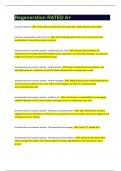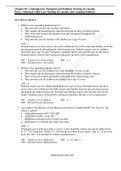Regeneration RATED A+
economic activity - ANS measured by employment and output data, GDP and gross value added
economic specialisation and structure - ANS places needing regeneration may increase economic
specialisation or diversify economic structure
characteristics of economic activity - health (measure, link) - ANS measured by morbidity, life
expectancy and ill health, direct link between place, deprivation and associated lifestyles, and between
health and economic sector/employment type
characteristics of economic activity - health decline - ANS fewer manual jobs and air pollution, but
working long hours or exposure to harmful chemicals/pollutants increased poor health
characteristics of economic activity - health inequality - ANS BAME groups worse overall health (poorer
socio-economic position), inner cities suffer food shortages and influx of cheap/unhealthy
processed/takeaway food
characteristics of economic activity - health in UK - ANS councils given responsibility for encouraging
healthier lifestyles in 2013, most smokers and binge drinkers in Newcastle-upon-Tyne
characteristics of economic activity - healthcare postcode lottery - ANS 2015 NHS Atlas of Variation
highlighted uneven distribution of health services (particularly mental health, early cancer diagnosis and
emergency care for elderly)
characteristics of economic activity - life expectancy UK average - ANS male 77.2, female 81.6
characteristics of economic activity - life expectancy UK variations - ANS North East and North West
below average, Kensington and Chelsea (highest earnings, £60,000/year+) life expectancy 5 years
greater
,characteristics of economic activity - life expectancy variations explanation - ANS social factors (cultures
and lifestyle choices), economic factors (individual wealth) and locational factors (access to healthcare)
characteristics of economic activity - education uneven distribution (income) - ANS provision and
outcomes highly unevenly distributed, often linked to income levels (Joseph Rowntree Foundation: 14%
variation in individual performance due to quality of school attended)
characteristics of economic activity - education Ofsted finding - ANS working-class white children in
poverty lower achieving and likely to continue to underachieve (31% achieve 5+ grade A-C GCSEs at 16),
characteristics of economic activity - education uneven distribution (gender) - ANS boys more likely to
have low results, especially Bangladeshi, Pakistani and black African
deindustrialisation of steel in North (job losses) - ANS 4 jobs lost for every steel worker redundancy
(wider suffers negative multiplier effect)
economic success in South - ANS generated 37% UK's growth output 1997-2007, 48% since 2008 (only
region in England to not experience relative decline), ¼ population generate ½ economic growth
Blackpool deprivation - ANS 3/5 England's most deprived places, deprivation in city centre, 29.5% child
poverty (50% in some wards), 41% employees work part-time
function of places - ANS role a place plays in community and surroundings, may grow, disappear, and
change over time, larger areas have regional, national or global functions
London administrative area vs functional area - ANS economic function wider than immediate
administrative boundaries, economic footprint includes other cities in South East
, changing function - Robinson's paper bag factory - ANS founded in Bristol 1844, one of biggest paper
bag factories in world, redeveloped and converted into 100 high-end apartments, retained original
structure, won Bristol Civic Society Environmental Award 2011
physical factors explaining changing characteristics - ANS proximity to large cities and core economic
zones, environmental attractiveness, technology facilitating urban sprawl (lifts allow high-rise buildings)
accessibility and connectedness explaining changing characteristics - ANS access to other places by
road/rail/air, greater connections generate competition for investment and visitors
historical development explaining changing characteristics - ANS primary production and manufacturing
declined during deindustrialisation, historic buildings can be asset for regeneration, but large areas of
derelict land and residual toxic waste can also be deterrent
role of national and local planning explaining changing characteristics - ANS 1990 policy increased
student numbers to 50% in some areas, tight controls from 1948 to preserve newly introduced green
belts, planning laws updated 2013 to streamline process (but criticised for removing careful
consideration and consultation)
measuring changes - ANS land-use, employment trends, demographic changes and deprivation
Index of Multiple Deprivation - ANS used by central government and local authorities to target
regeneration support, allocate resources and focus on deprivation hotspots
Index of Multiple Deprivation LSOAs - ANS includes 32,844 lower-layer super output areas with 1500
people and 650 households
Index of Multiple Deprivation ranking - ANS ranked by relative deprivation, not every person in highly
deprived area is deprived, some deprived people live in highly affluent areas





